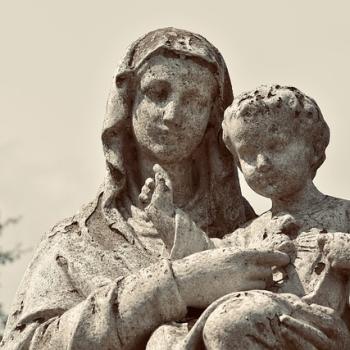
My mother’s family were Irish, from Waterford; they ended up in Columbus in the late nineteen teens. They lived down in Franklinton, with the other Irish immigrants, all the pale-skinned ginger-haired Catholics who didn’t count as “white” in the nineteen teens. Franklinton was also called “The Bottoms” because it was geographically in the river-bottom, below the levels of the Olentangy and the Scioto. The Bottoms flooded regularly, but nobody cared– it was only the Irish people who lived there, not Americans. Once, a flood almost killed them all. Great Grandmother Anna Rita was rescued out of a second-story window by a passing man in a rowboat. I have no idea who that man was or whether to thank him; but for better or worse, if he hadn’t been there, I wouldn’t have been born, and you wouldn’t be reading this rambling memoir.
In any case, Great Grandmother Anna Rita was rescued. In the 1920s, African-Americans from the South moved into The Bottoms and the Irish suddenly found themselves culturally accepted as white people and Americans, so they moved to other parts of Columbus. By the time I came along, Great Grandmother lived in half a duplex in a respectable part of town. I used to visit her almost every week. She had a green foil pot of live shamrocks that blossomed with little white flowers, and a green teddy bear with “Kiss me I’m Irish” embroidered on the tummy, both stuck on a high shelf away from children’s hands. I wasn’t allowed to kiss the bear, and I didn’t want to kiss Great Grandmother. I was shy of her.
I was told again and again that we were Irish, and that was wonderful, and Saint Patrick’s Day was a supremely important holiday for the Irish– even though Saint Patrick himself wasn’t Irish. He was brought to Ireland, the first time, against his will, and didn’t like it one bit. He eventually escaped. By the grace of God, he came back, on purpose this time, preached a sermon involving a shamrock, baptized the Druids, drove out the serpents, and may have transformed one wicked chieftain into a fox but probably not. He is remembered and portrayed as a white, suspiciously Irish-looking man with a long gray beard in a modern bishop’s outfit, awkwardly holding a shamrock. I wasn’t supposed to question this portrayal any more than I was supposed to question anything else.
We went to various churches around Columbus, for various reasons, but eventually settled at the Irish one– Saint Patrick’s Church, of course. A great to-do was made about Saint Patrick’s Day every year there. A lot of Americans just drink on Saint Patrick’s Day, but at Saint Patrick’s Church, we prayed. First there was Mass, in the old church with the choir loft and Communion rail. We sang Ag Croist An Siol, hideously mispronouncing all the vowels as if they were Latin. I sang with the choir as an alto. While we sang, I had a fleeting sense of belonging– music acts on the soul in ways that spoken prayers do not. I felt that I was Irish and I was singing an Irish prayer, and part of something more than myself, but that feeling never lasted. After Ag Croist An Siol, there was the interminable Litany of Irish Saints, where I learned that there had been a time and place in history when it was normal to name girls Cunegunda, Columba, Dymphna and Attracta, and boys Gall, Fursey, Celsus and Muredach. “Grant, O Lord, an increase of Thy Grace to us who celebrate the memory of all the Saints of our Island; that as, on earth, we rejoice to be one with them in race, so, in Heaven, we may deserve to share with them an inheritance of bliss. Through Christ Our Lord. Amen.”
But Ireland wasn’t my island.













